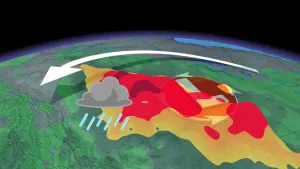
North Americans are eating and inhaling microplastics daily
The paper was published Wednesday in Environmental Science & Technology.
A new study suggests North Americans are eating, drinking and inhaling tens of thousands of tiny plastic particles annually, but researchers aren't sure what impact it is having on human health.
Microplastics are produced when plastic breaks down in the environment. University of Victoria biologists believe individuals eat between 39,000 and 52,000 of tiny plastic particles each year. Those who drink mostly bottled water could be consuming an extra 90,000 pieces, and breathing introduces an additional 35,000 to 69,000 particles annually, according to the paper.
University of Victoria biologist Kieran Cox, the lead author on the paper, says more research needs to be done to understand the implications of his findings.
"The last thing I want to do is cause some sort of undue alarm over plastics," he told the Canadian Press.
"But even if we're considering what I would call a pretty limited literature, we're getting into hundreds of thousands (of particles) a year. That's a non-trivial dose."
While Cox and his team found no studies documenting microplastics on meat and vegetables, they found 26 studies on fish, shellfish, sugar additives, salts, beer and on bottled and tap water.
RELATED:
They then estimated how much that is consumed by the average North American, using food guidelines as a reference.
Cox says the paper likely underestimates the amount of microplastics North Americans consume because the study only accounts for 15 percent of the average person's caloric intake.
THE PLASTIC PROBLEM
While plastic is an integral part of modern society, the "miracle material" has a downside. It's estimated that 1 billion tonnes of plastic have been discarded since the 1950s and research suggests it will take up to 500 years for some forms to biodegrade.
According to the U.S. Environmental Protection Agency, only 8 percent of the total plastic waste generated in 2010 in the U.S. actually made it to recycling plants.
Here in Canada, an estimated 90 percent of the country's plastic is not properly disposed of.
A paper by the MacArthur foundation analyzes the current rate of plastic making its way into the world's oceans, and offers a projection for the future.
"The new report acknowledges that while plastics and plastic packaging are an integral part of the global economy and deliver many benefits ... most plastic packaging is used only once," reads a statement on the Ellen MacArthur Foundation's website.
"Given projected growth in consumption, in a business-as-usual scenario, by 2050 oceans are expected to contain more plastics than fish (by weight)."
According to the report, at least 8 million tonnes of plastics leak into the ocean every minute, a number that's expected to double by 2050 if no action is taken.
The paper acknowledges that reducing the amount of plastic in the ocean will require "major" global collaboration, but the authors believe change is possible.










